
Tower 42, commonly known as the NatWest Tower, is a 183-metre-tall (600 ft) skyscraper in the City of London. It is the fifth-tallest tower in the City of London, having been overtaken as the tallest in 2010 by the 230-metre (750 ft) Heron Tower. It is the fifteenth-tallest in London overall. Its original name was the National Westminster Tower, having been built to house NatWest's international headquarters. Seen from above, the shape of the tower resembles that of the NatWest logo.

The Columbia Center, formerly named the Bank of America Tower and Columbia Seafirst Center, is a skyscraper in downtown Seattle, Washington, United States. The 76-story structure is the tallest building in Seattle and the state of Washington, reaching a height of 933 ft (284 m). At the time of its completion, the Columbia Center was the tallest structure on the West Coast; as of 2017, it is the fourth-tallest, behind buildings in Los Angeles and San Francisco.

Southwark Towers was a high rise building at 32 London Bridge Street, designed by TP Bennett architects, overlooking London Bridge station, in Southwark, London. When it was demolished in 2008 to make way for The Shard, it was jointly the tallest building ever to have been demolished in the United Kingdom, alongside the Drapers' Gardens tower.
1201 Third Avenue is a 235.31-meter (772.0 ft), 55-story skyscraper in Downtown Seattle, in the U.S. state of Washington. It is the third-tallest building in the city, the eighth-tallest on the West Coast of the United States, and the 97th-tallest in the United States. Developed by Wright Runstad & Company, construction began in 1986 and finished in 1988. 1201 Third Avenue was designed by Kohn Pedersen Fox Associates and The McKinley Architects. The building was the world headquarters of the financial company Washington Mutual from the building's opening until 2006, when the company moved across the street to the WaMu Center.

Broadgate is a large, 32-acre (13 ha) office and retail estate in the Bishopsgate Without area of the City of London. It is owned by British Land and GIC and managed by Savills.
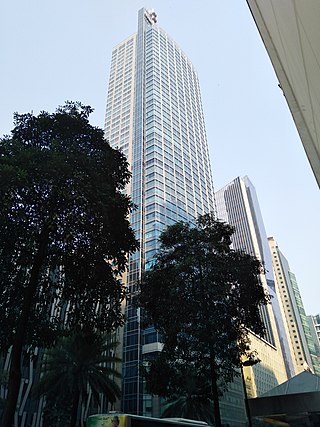
The Philippine Bank of Communications Tower, more commonly known as PBCom Tower, is an office skyscraper ranked officially as the second tallest building in the Philippines. It was previously the tallest building in the Philippines, a title it held starting year 2000 until the completion of Federal Land Tower in early 2017. It has a total ground to architectural top height of 259 metres (850 ft), with 52 storeys including an 8-level radio tower. It is a joint development of Filinvest Asia Corporation (FAC) and the Philippine Bank of Communications (PBCom). The building is the home of PBCom, one of the oldest Philippine banks. The bank occupies the building's first ten floors, with a food court on the seventh floor.

Richard Seifert was a Swiss-British architect, best known for designing the Centre Point tower and Tower 42, once the tallest building in the City of London. His eponymously named practice – R. Seifert and Partners was at its most prolific in the 1960s and 1970s, responsible for many major office buildings in Central London as well as large urban regeneration projects in other major British cities.

St Paul's Tower is a skyscraper located on Arundel Gate in Sheffield, South Yorkshire, England. Construction commenced in May 2006 and the building was topped out in August 2010, surpassing Sheffield University's Arts Tower as the tallest building in Sheffield at 101 metres (331 ft) tall. The city's first skyscraper, it was constructed as the centrepiece of the St Paul's Place project as part of the Heart of the City redevelopment of Sheffield city centre.

Chase Tower is a 40-story skyscraper at 201 North Central Avenue in Phoenix, Arizona. Opened in 1972, the building was designed by architects Welton Becket and Fred M. Guirey. The skyscraper is located in Central Avenue Corridor, an economic and residential region of Downtown Phoenix.
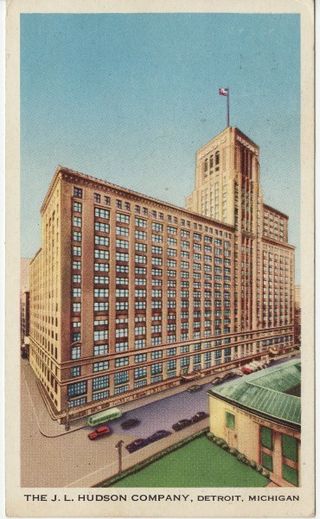
The J. L. Hudson Building ("Hudson's") was a department store located at 1206 Woodward Avenue in downtown Detroit, Michigan. It was constructed beginning in 1911, with additions throughout the years, before being "completed" in 1946, and named after the company's founder, Joseph Lowthian Hudson. Hudson's first building on the site opened in 1891 but was demolished in 1923 for a new structure. It was the flagship store for the Hudson's chain. The building was demolished in a controlled demolition on October 24, 1998, and at the time it was the tallest building ever imploded.

The Bow is a 158,000-square-metre (1,700,000 sq ft) skyscraper in downtown Calgary, Alberta, Canada. The 236 metre (774 ft) building was the tallest in Calgary between July 8, 2010, when it surpassed the Suncor Energy Centre, and May 11, 2016, when it was exceeded by Brookfield Place. The Bow is currently the second tallest office tower in Calgary and the third tallest in Canada outside Toronto. The Bow is also considered the start of redevelopment in Calgary's Downtown East Village. It was completed in 2012 and was ranked among the top 10 architectural projects in the world of that year according to Azure magazine. It was built for oil and gas company Encana, and was the headquarters of its successors Ovintiv and Cenovus.

1600 Pacific Tower, also known as the LTV Tower, is a skyscraper in the City Center District of Dallas, Texas, USA. The building rises 434 feet. The structure contains 33 floors, made up originally of office space, standing as the 29th-tallest building in the city. The building is adjacent to Thanks-Giving Square and was, for a time, connected to the Dallas Pedestrian Network.
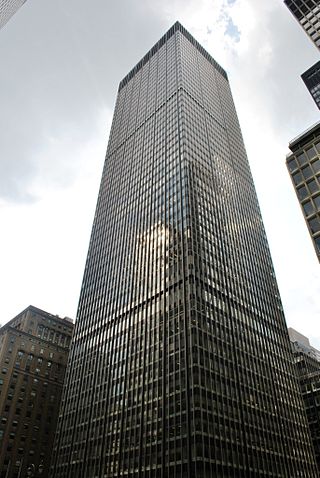
270 Park Avenue, also the JPMorgan Chase Tower and Union Carbide Building, was a skyscraper in the Midtown Manhattan neighborhood of New York City. Built in 1960 for chemical company Union Carbide, it was designed by architects Gordon Bunshaft and Natalie de Blois of Skidmore, Owings & Merrill (SOM). The 52-story, 707 ft (215 m) skyscraper later became the global headquarters for JPMorgan Chase. When it was demolished in 2021, the Union Carbide Building was the tallest voluntarily demolished building in the world. A taller skyscraper with the same address, to be completed in 2025, is being constructed on the site.
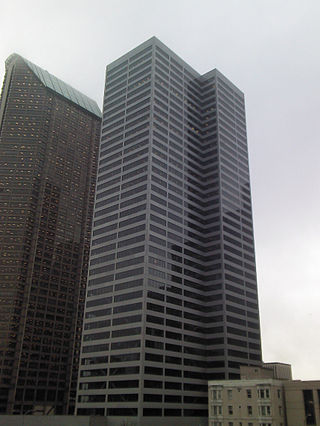
800 Fifth Avenue is a 166-meter (545 ft) skyscraper in Seattle, in the U.S. state of Washington. It was constructed from 1979 to 1981 and has 42 floors. It is the tenth-tallest building in Seattle and was designed by 3D/International.

South Quay Plaza is a residential-led development under construction in Canary Wharf on the Isle of Dogs, London, within the borough of Tower Hamlets, developed by Berkeley Group Holdings and designed by architect Foster + Partners. The site of the development lies to the immediate north of Marsh Wall and to the immediate south of the financial district Canary Wharf. The entire development is scheduled for completion in 2028.
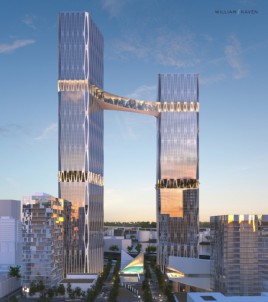
The Broadway Corridor twin towers complex was a proposed mixed-use skyscraper complex in the Pearl District of Portland, Oregon. Multi-disciplinary architecture firm William Kaven Architecture proposed the complex as a potential part of the Broadway Corridor redevelopment project. The twin-towered skyscrapers would reach 970 feet (300 m) in height and would have become the tallest building in Oregon, the tallest twin towers in the Western Hemisphere and fifth-tallest in the world. A significant obstacle to the proposal was that current zoning at the site limits building heights to 400 feet (120 m). The proposal was not among the list of three finalists chosen by Prosper Portland in March 2018.

Four, also known as Four Frankfurt, is a major, luxury mixed-use skyscraper project in Frankfurt, consisting of a complex of four skyscrapers under construction. It is located in the area known as the Deutsche Bank triangle in the Innenstadt borough. The tallest skyscraper will have a height of 233 metres (764 ft), making it Europe's largest residential tower by occupied floor space. Germany's largest building, the Commerzbank Tower is larger by building height but not when measured by occupied floor space height. By total building height it is both Frankfurt and Germany's third-tallest building upon its estimated completion in 2023. Dutch star-architect and student of Zaha Hadid, Ben van Berkel has designed and developed the building.


















